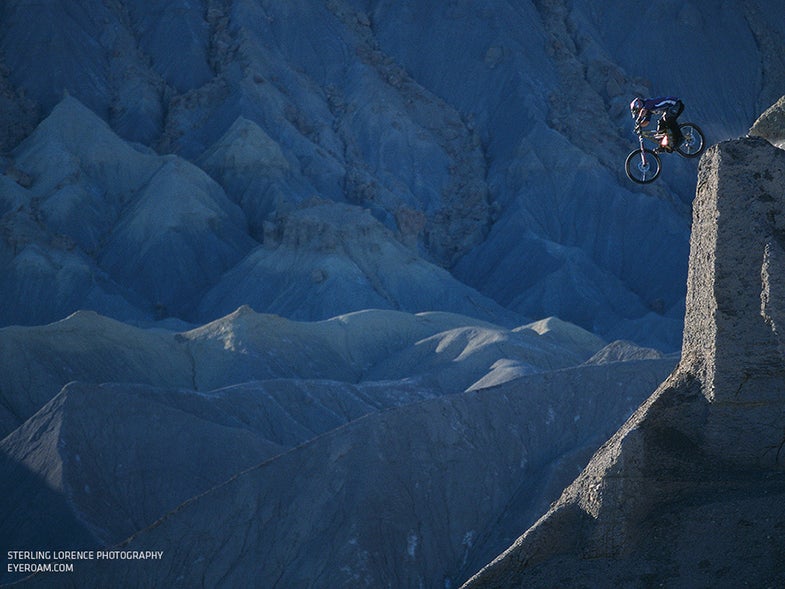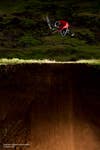Tips from a pro: Shoot better mountain bike photos
Pro Sterling Lorence tells us how to go into the woods with a camera and come out with great photos.

To many people in the mountain biking industry, Sterling Lorence is known simply as “Sterl.” He’s been a fixture in the scene for years and his photos have appeared just about everywhere. In fact, he currently has the cover of Bike Magazine’s Photo Annual. I met up with Sterl at the holy land of mountain biking, Whistler mountain, where he was shredding trails with a backpack full of photo gear. He agreed to share some of his wisdom when it comes to capturing mountain bikers in their native habitat.
What are some common mistakes people make when shooting mountain biking photos?
Biking can look very stagnant, so it’s important to make sure your photo has an element of action. Concentrate on dynamic parts, like cornering, out-of-the-saddle pedaling, or a cool jump. If you don’t have a good movement, then try to frame the rider with dramatic environmental elements. Sometimes making the rider small helps emphasize the scale of their surroundings. Obviously, it helps to have a beautiful location mixed with gorgeous light, so scouting is key.
What do you look for in a location for getting good MTB shots?
Mountain bikes are very capable creatures, so they’re great for exploring. I look for spectacular landscapes that would be interesting even without the bikes. It’s also crucial to understand how the sun will move across a location. That way you can choose the best light for your shoot.
One thing you do very well is compose landscape photos that bring mountain bikers in on a small scale. Can you talk a little about how you developed that as part of your style?
When I see a dramatic piece of the earth, I love showing as much of it as possible. Sometimes you’ll come across something special happening between the light and the terrain. That’s something I chase. I want to show it, so I’ll shoot a looser landscape. It can change so rapidly. A range of mountains with some single tracks can look average in the middle of the day. But, by the end of the day, it could be exploding through a thunder storm.
How much do you rely on flashes or artificial light?
As a commercial shooter, flashes and strobes are part of my regular shoots. The level of sophistication is ramped way up and the reward can be intensified, but the time requirements and weight can be limiting for mountain bike shoots. I try to use them in a subtle way, though. If I’m shooting a tight action shot, I’ll use a small pop of backlight to reveal the subject a little more. You can’t always rely on the weather to hand over brilliant sunset light.

TECH SPECS:
Camera: Canon 1D Mark IV
Lens: 24mm
Shutter Speed: 1/60 sec.
Aperture: F/3.2 Sterling Lorence
How does being a mountain biker help you in understanding what it takes to make a good MTB photo?
I love mountain biking, photography, and exploring the natural environment. That intimate knowledge helps me make choices about what makes a good shot. I’m not just shooting away and fishing for a lucky image. The moment has to be stoking my vision before I even pull out my camera. Because I’m in tune with the sport, I feel I have a good sense of where it has been, where it is currently, and where it is headed. Rarely do I say to myself, “I want to try and get a shot like that one in the mag.” You’re way behind if you’re doing that.
Are there any MTB photo cliches that you try to avoid?
The classic stock shot you still see in commercial applications where the ‘mountain biker’ is wheeling through a dirty Utah puddle. Everything is lit perfectly and the rider has a big smile on his or her face. It’s boring.

What does your typical kit look like if you’re going to be shooting a day on the mountain?
My gear varies from shoot to shoot. My standard kit for a shoot up in the mountains is one Canon 1D X, a 70-200mm f/2.8, a 24mm, a 50mm, a fisheye, and maybe the 300 f/2.8 if really needed. I often have to ride my bike to the locations, so sometimes I hand off the 300mm to my riders to carry.
If I have access to a vehicle or my assistant and I can get to the location with a light hike, the kit expands. I use an Elinchrome Quadra kit, Hensel port pack kit, speed lights, stands, booms, reflectors, and added lenses. Sometimes I’ll even bring the Hasselblad digital kit.

TECH SPECS:
Camera: Canon 1D Mark IV
Shutter Speed: 1/400 sec.
Aperture: F/2.8 Sterling Lorence
What do you do about keeping your gear safe from all the dirt and mud?
I don’t fret too much about my gear. When I am in dusty locations, I carry compressed air to keep blowing the gear clean. For the rainy shoots in Vancouver, I rely on umbrellas stationed at all my bags, and I use zip locks to protect the speed lights and Pocket Wizards. I use Dakine backpacks and travel bags, which are all made with removable shell jackets to keep the wet out.

TECH SPECS:
Camera: Canon 5D Mark II Lens: 35mm
Shutter Speed: 1/500 sec.
Aperture: F/10 Sterling Lorence
If you don’t have dramatic terrain around your house (like a bike park or a sweet jump track), are there any techniques you can suggest for making shots look a bit more dramatic?
You can always count on sunrise or sunset light to make things dramatic. Look for nice backlighting across the land, which helps mask the foreground details that may be less impressive. If you have access to a forest, look for those really wet and nasty days that act like a soft box for light inside the canopy. Fog can add mystical feel that can make the local forest look more interesting.
Off-camera flash can also add drama. Put some flashes behind the rider and start there. You will be stoked at the added separation that helps make your rider pop.
If the location is really drab, consider shooting really tight on the rider and with a shallow depth of field. The emotion and attention in the image is driven by the rider’s eyes. The action and the shallow depth of field will help blur distracting elements. This one relies a lot on the rider, though. It works a lot better if they’re really shredding.


TECH SPECS:
Camera: Canon 1D Mark III
Focal Length: 120mm Shutter Speed: 1/1,250 sec.
Aperture: F/3.2 Sterling Lorence



TECH SPECS:
Camera: Canon 1D Mark IV
Focal Length: 150mm Shutter Speed: 1/500
Aperture: F/3.2 Sterling Lorence
